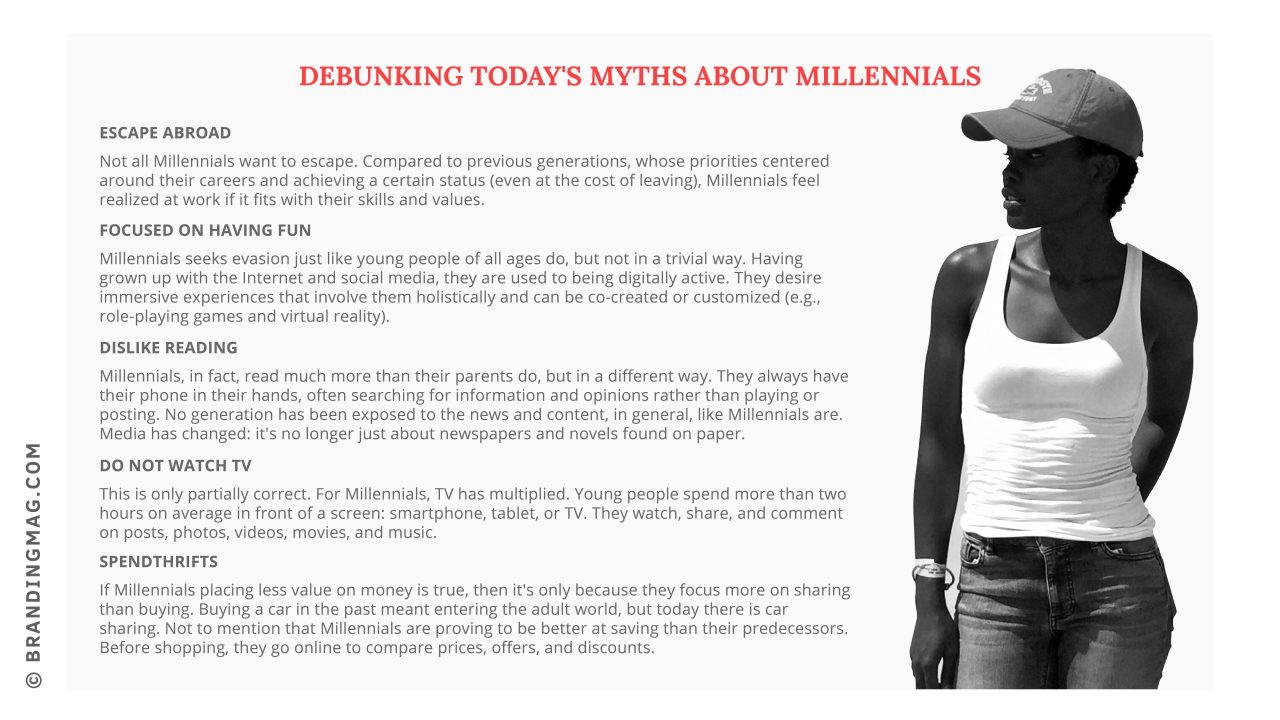
Millennials (also called Generation Y) represent the generation of users born between 1980 and the first half of the 90s. The most striking feature of Millennials is that they are the first generation familiar with digital technology and well-versed in its codes of communication in their adulthood. For many, the immediate social change stems from the cognitive system of this group — one radically different from previous generations given that it is more complex, reticular, relational, and rapid.
The so-called “Millennial Explosion” comes about when we realize how different this generation is, and how much the social and cultural context in which we live (and will live) is changing. The problem is that many of the diagnoses made about this generation stop at behaviors and do not delve into the underlying, deep values and motivations of purchasing processes and everyday life, as well.
Although Millennials have been put under the magnifying glass, studied, psychoanalyzed, and crowned as the generation to bet on, marketers are still struggling to reach them. We limit our observation of them to when they are connected to the Internet, when they exchange opinions and data on social media, when they take selfies. The world of communication and marketing still seems trapped by stereotypes and false myths, risking to direct brands towards wrong and ineffective choices (see below).

It is important to understand that Millennials have acquired a “web-forma-mentis” from adolescence: they grew up with the idea that everything can be obtained immediately, that information is always available, and that there are no subjects with whom you cannot communicate at any time. They have understood that they can make a successful video without being a director, evaluate a product without being an expert, or write a blog talking to tens of thousands of users without being a celebrity. Millennials grew up in the era of Web 2.0 and today they transpose in the so-called “real world” all of the values and dynamics found in the collaborative environment of social networks. This is what characterizes a “Millennial Mindset” that behaves, talks, and thinks in a unique way, having grown up:
- without limits of space because the availability of information and content is immediate even if produced on the other side of the world;
- without limits of time because on the Web content is born, dies, and comes back continuously ;
- without limits of communication because they speak, write, and post about everything, with everyone, in any way possible ;
- without an on-off switch because they are always on or never off;
- without privacy because social networks and companies host them by providing space for expression, but asking for personal data;
- without objects because they do not care about owning things, but rather sharing them – making them affected by the service and individual benefit and not the object itself.
Millennials, now 18-30 years old, are the first to have spent their adolescence in digital environments and social networks. This is what makes them different from all others: their identity and relational models have formed in connected systems where space, time, and the traditional rules of “good” communication no longer exist. Moreover, the future does not exist; social and economic uncertainties together with Millennial’s natural attitude of living in the moment destroys every desire for anticipation, planning, and thinking about long-term goals. If you talk to a Millennial, don’t ever ask her what she wants to do when she grows up or what she imagines the future will look like in five years – she wouldn’t know how to answer. She would believe that everything changes instantly depending on what she does today and that there is no certainty for the future.
The system of relationships built by this generation is based on these key principles, which then form the system of expectations that they have towards schools, institutions, companies, brands, and communications. Each branding activity is supposed to be social or suitable for sharing, part of a brand relationship built on the inherent elements of transparency and authenticity, immediate and responsive to events and stimuli, or linked to immersive and memorable experiences.
Marketing (R)Evolution: How Brands Can Attract Millennials
If the marketing architected for Baby Boomers (those born between 1945 and 1964) was a marketing that talked about positivity and the future, and marketing for Generation X (those born at the turn of the ’70s and before the ’80s) was a marketing responding to that era’s society of conformity and consumption, then the marketing of Generation Y and Z (those born in the ’80s, also called Millennials and Centennials, respectively) is, should be, or will be marketing designed for the connected society. Unfortunately, few companies today understand the contemporary world and are often seen proposing stereotypes or, even worse, talking about – and to – a forgotten world when talking about young people.
Marketing to Generation X comprises of commercials and TV spots; marketing to Millennials, however, consists of storytelling and digital. The marketing of the ‘80s is top-down, while post-2000 marketing is participatory. The truth is that many of the marketing directors studying, targeting, and communicating with Millennials are part of Generation X and most likely misunderstand this generation much different from theirs.
Marketing to Millennials requires an approach based on the communication principles of new generations and adaptive to new ways of using media and content relevance, focusing on experience while generating value. Millennials are creating new patterns of consumption, new patterns of choice, new ways of using media, and new ways of relating to brands and advertising that we can no longer underestimate. TV-centric marketing, focused on generating awareness and brand associations for consumers to remember until the moment of purchase, cannot cope with the current level of complexity. Instead, the “Millennial Explosion” — while transforming society’s system of values through its youngest people — begs companies and marketing planning to transform in ways beyond the technological and digital. It stimulates us to think and act like Millennials, in a social and reactive way, focusing on the content, the service, and the experience, all while generating value.
This new approach should be based on the following five pillars. These steps are not to be followed one after another, but rather are activities to be conducted and mixed together.
- Listen to markets. Proactively listen to markets and consumers; seek out consumers and their expressions across the myriad of touchpoints available to them; switch from listening in order to reply to listening in order to understand;
- Pop-up in moments. Identify and participate in important moments for your consumer, without shooting at random; recognize the specific moments, situations, and opportunities that will gain attention and be relevant;
- Surprise with content. Create surprise, stand out from the crowd, and help the consumer see beyond suggested and precoded choices, combining engineering and creativity to deliver high-impact content;
- Enrich experience. Amplify the individual pre-/during/post-purchase, using all of the touchpoints capable of affecting satisfaction and reputation – and not stopping at the point of sale or at the end of a campaign;
- Connect with brand purpose. Reconnect all of the touchpoints and individual experiences with your brand’s universal values, its identity, and the role it wants to play for the consumer.
Content Marketing: Key Rules for Communicating with Millennials
Millennials were born in the middle of media fragmentation, in a phase of great proliferation of television channels, websites, and social media that led them to be multitaskers. They like sharing their experiences everywhere with everyone. When it comes to communication as one of the four components of the classic marketing mix, there are two situations to consider. On one hand, all of this complicates the lives of marketing managers dealing with advertising and video content as it makes breaking through and conquering the Millennial audience more difficult; on the other hand, it can simplify everything because that audience is potentially a more involved and interactive one.
Communication, for some time now, is no longer a one-way street that goes from the producer to the consumer, from the television program/video/story to the viewer. Millennials expect to be able to establish a dialogue (company-consumer) with the brands they are interested in; they want to be able to communicate what they like and what could be improved. They also love to communicate with each other, sharing their experiences and becoming part of communities made up of people with similar interests. In this sense, social media integration is undoubtedly one of the key success factors for the supply of content and companies’ communication policies. Additionally, Millennials use their networking skills to get what they want, taking advantage of the scarce financial resources available without renouncing the quality of their experience. Just think of crowdsourcing, crowdfunding, and (of course) the opportunities offered by the sharing economy.
The cultural gap resulting from marketing rules established with Generation X in mind leads companies to continue depending on TV-centric strategies, with goals related to awareness. But contextual complexities and new, tech-enabled opportunities require different strategic frameworks when looking to build successful brands. The multitude of manners in which we live and contact channels; the non-linearity of communication and purchasing processes; the connection between people, places, moments, and objects; and the coexistence of very different generations (Baby Boomers, Generation X, Millennials, and Centennials) have all reduced the effectiveness of communications. The challenge now is to communicate and attract multiple generations, in all their diversity, simultaneously. Indeed, it is not what you say, but how you say it that matters.
Companies need to adopt a new marketing model, one that looks to the future and is inspired by the new generational paradigm of communication and relationship.
Want to be heard effectively by a segment increasingly gaining purchase power? Here are five key rules for efficient and compelling content marketing:
- Segment the content based on cultural interests. Millennials find cultural interests to be the most important parameter – even more than age and proximity – motivating them to fruition and sharing. To engage Millennials, it is extremely important to create content tailored to their individual interests. Brands have to take into consideration not only socio-demographic aspects (such as gender, age, location, education, purchasing power, etc.), but also psychographic and behavioural aspects such as cultural interests, attitude, and opinions;
- Make yourself useful. Brands are supposed to have more than just a promotional role. They should convey inspiration, entertainment, educational value, and relevant information. Millennial audiences respond positively to the utility factor and refuse to read contents not related to edutainment;
- Make Millennials laugh. Brands should be funny, while remaining anchored in authenticity and relevance. Humor and self-irony are not words to watch with suspicion, but rather the primary ambassadors for becoming viral among Millennials. Brands need to create an emotional connection that gives Millennials a real reason to connect with content and increase the likelihood of building trust;
- Short is better. Generation Y often abandon or avoid content that is too long, not dynamic enough, or not incisive. Brands should ban one of the most widespread errors: prolific and lengthy storytelling;
- Go where Millennials are. Social networks such as Facebook triumph in the search for content, surpassed only by Google. Millennials “consume” content on different platforms in terms of physical devices, apps, and social media channels. What are the preferred platforms? None. Tastes change constantly. To keep brand content relevant, companies need to follow the target audience on whatever channel it spends its time: yesterday it was Twitter, today it’s Instagram and Snapchat.
Cover image: Nathan Dumlao
